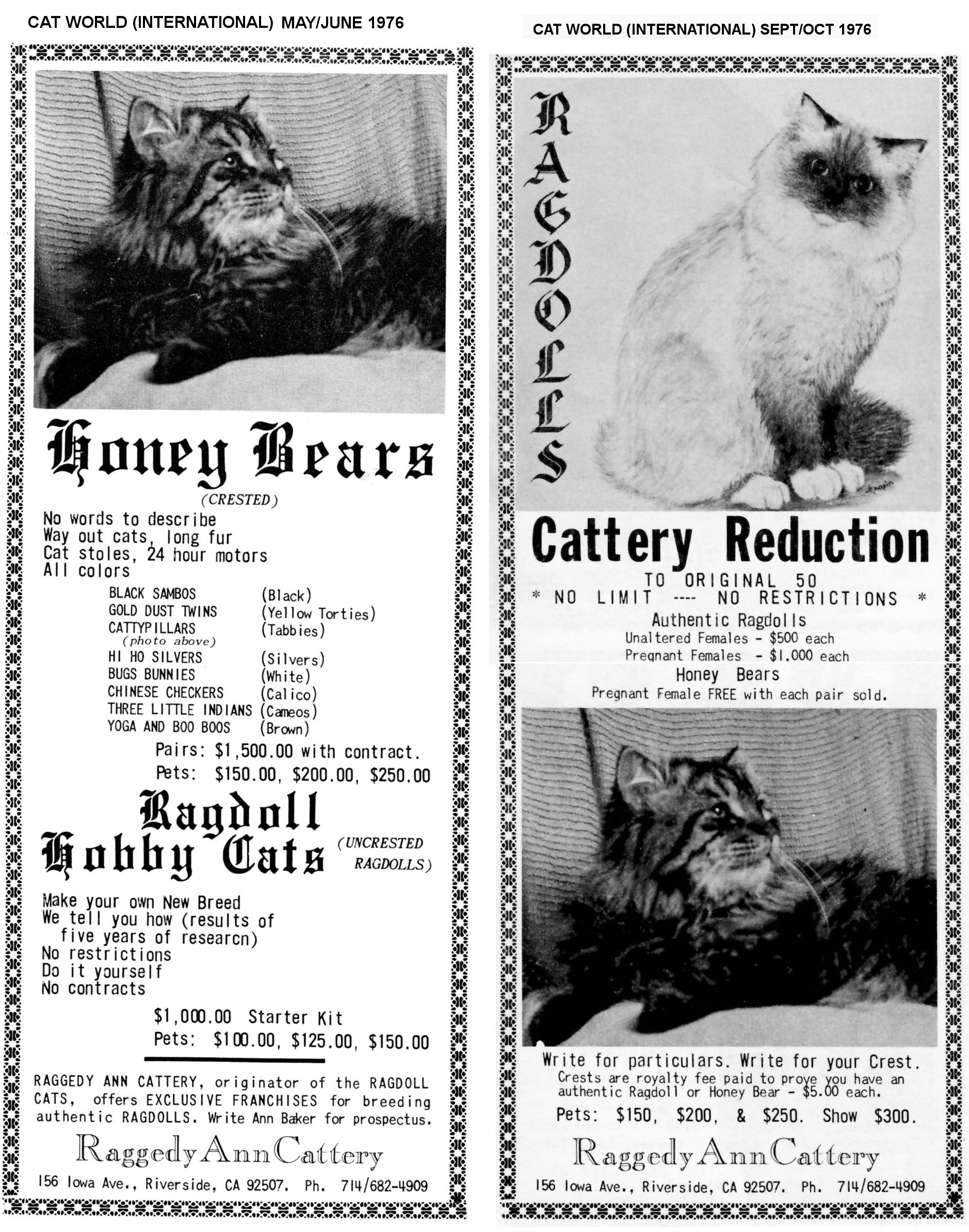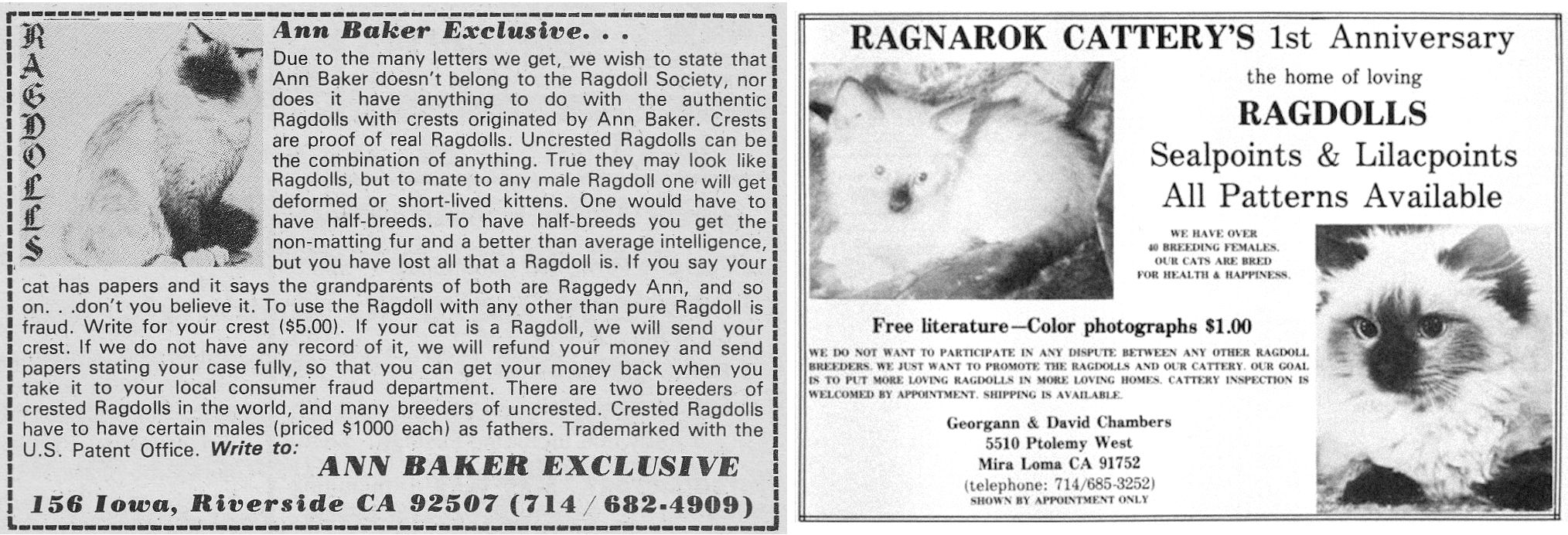
THE IRCA LONGHAIRS - RAGDOLLS, RAGAMUFFINS, HONEYBEARS AND CHERUBIM CATS (RAGAMUFFINS)
IRCA AND CHERUBIM CATS
The Ragdoll originated in California in the early 1960s and is surrounded by myth thanks to their somewhat eccentric breeder, Ann Baker. Ann Baker bred Persian cats. Josephine was a white Persian-Angora cat belonging to Baker's neighbour; she was a semi-feral who produced kittens as wild as herself. After Josephine was hit by a car she had to stay indoors while recovering and she became somewhat tamer. Josephine's earlier litters had been half wild like their mother, but those born after the road accident were very relaxed, docile and social. The most likely explanation is that she was breeding with different males, ones carrying genes for more sociable offspring, and that the kittens were raised closer to humans. Judging by the kittens' appearance, Josephine's suitors were most likely Birman and Burmese.
Baker decided to create a new breed, one which retained the very sociable, relaxed traits, non-matting fur, large size and the property of going limp when handled. She acquired a black Burmese-looking female called Buckwheat and a bicolour female called Fugianna. Fugianna's sire was another of Josephine's kittens, a seal-point Birman-type cat called Daddy Warbucks. There were to be no more founding cats since Josephine and her next litter were destroyed by their owner. Based on the appearance of the two founding females, Baker split their progeny into two groups: Fugianna's kittens were termed "the Light Side"; Buckwheat's kittens were termed "the Dark Side".
Ann Baker formulated a strict breeding policy to preserve the purity of the Ragdoll and charged other breeders (franchisees) a royalty fee for every kitten they sold. She also made wild claims about the cats: their docility was due to changes in Josephine after she was hit by a car (a long-discredited Lamarckian theory), that while Josephine was being treated for injuries she was infused experimentally with skunk and/or racoon and/or human genes (even if done, these genes would not have entered the egg cells in the ovaries), that Ragdolls were immune to pain (they have normal pain thresholds but are remarkably tolerant cats) and even that they are a link between us and space aliens! A more plausible suggestion was that Josephine had a mutation in her ovaries and this mutation was present in the egg cells (a germ-line mutation) and was passed on to her offspring.
Her claims and methods alienated other breeders, some of whom broke away to develop the Ragdoll into a registrable breed using sound breeding practices. Depending on which history you read, the Ragdoll was recognised as a purebred cat in 1965, 1966 or 1967. Also according to many sources, Denny Dayton achieved US recognition for the Ragdoll in 1967, however he didn't buy his first Ragdolls until November 1969. In 1971 Baker created the International Ragdoll Cat Association (IRCA) and claimed that non-IRCA cats to be fakes, frauds, look-alike, half-bred, not authentic etc while promoting her cats as the only legitimate Ragdolls. In 1975 Baker patented the Ragdoll name; she died in 1997 but her patent remained valid until 2005 and allowed only IRCA breeders to use the name "Ragdoll". Earlier breakaway breeders felt that the restriction did not apply to them because they had purchased and bred their cats prior to the time of the patent. In 1981, Ragdolls were exported overseas for the first time.
According to Kay Hanvey, who was involved at the time, when Denny and GeorgeAnn Dayton bought cats from Ann Baker they also had to buy special food from her. Denny, a scientist, had this special food tested by a laboratory found phenobarbitol in it. This was why the cats were so limp and relaxed and had a high pain threshold. When the Daytons broke away from Ann Baker and switched the cats to a normal diet it turned out that the cats were not so laid back and they had a lot of work to do to breed cats with a really nice personality. Denny presented the findings of the food analysis in court. When the Daytons presented the breed to TICA for recognition it was on the basis that Ann Baker could not trademark or limit the breed further and that future Ragdolls from her would not be accepted.
The stories of the two types of Ragdoll ran parallel for many years. Baker's trademarked umbrella term for all of her IRCA varieties was Cherubim Cat meaning "Angels non-fighting cat". In 1985 and 1987, one UK breeder also advertised "Cherubinis" which appear to have been non-colourpointed offspring from outcrossing Ragdolls to other breeds. "Cherubini" was a legally safe equivalent of IRCA's trademarked "Cherubim" name. The IRCA Ragdolls were not recognised by any other registry and upon Baker's death, a number of breeders re-registered their Miracle Ragdolls, Honeybears and other IRCA varieties as foundation stock for the new RagaMuffin breed which is now recognised by many registries around the world. The RagaMuffin is not merely a non-pointed Ragdoll, it also has a different conformation from the Ragdoll. After Baker's death, some breeders tried to sell their IRCA Ragdolls as "rare mink-pointed Ragdolls" or "rare solid colour Ragdolls" to unwary owners/breeders who did not know that there had been two conflicting Ragdoll breeds. These "rare" colour cats, though attractive, were not registrable as Ragdolls in any other cat association.

Baker's Cherubim Cats included Ragdolls, Miracle Ragdolls ("a highly upgraded Ragdoll" formerly known as the "Ragdoll Tu", "experimental Persian" or simply "Miracle"), Ragdoll Hobby Cat, Honey Bears, Doll Babies, Baby Dolls, Shu Schoos, Symoneese/Symonees, Manxees, Fuzz, Catenoids and Little Americans. The named IRCA Ragdoll/Miracle breeding lines included Maximillions (silver tabbies), Minks, Bears (thicker fur, shorter ears, rounder eyes, flatter face, cobbier body) and Catenoids (blue-eyed solids surrounded by claims they could be bred to any cat to produce an IRCA-type Ragdoll!). Many of these never existed outside of Baker's cattery which held as many as 500 cats - in cages and free-roaming indoors. After the demise of Baker and of IRCA, many of these were absorbed into the RagaMuffin and some were apparently re-registered as TICA Ragdolls.
The origins included fanciful claims of secret government laboratories, infusions of skunk genes, human genes and/or alien DNA while a Catenoid would supposedly produce Ragdolls regardless of what you mated it to. Baker seemed increasingly unstable; she distributed photos of herself amidst a hundred dead kittens that she claimed were killed by rival breeders who broke into her home. Disturbed cat fanciers were certain she had killed them as part of a publicity bid and tried to figure how to get other cats safely away from her (I recall the pleas for information circulating on mailing lists at the time). Perhaps mercifully for the cats, Baker died in 1997. Her IRCA organisation limped along for a few years, but many breeders quit or defected to conventional registries (which had cat shows) and the IRCA trademark on Ragdolls lapsed in 2005.

Throughout her life, the eccentric Baker defended her breeds and claimed that only IRCA Ragdolls were the real article and guaranteed free from genetic defect, while other Ragdolls were half-bred or cross-bred inferior lookalikes trading fraudulently on the Ragdoll name. Quarter-page advertisements to this effect appeared in an American cat magazine in 1992. Periodically, she would send threatening mail to breeders non-IRCA Ragdolls, including a mailshot that contained photos of dozens of dead cats laid out side-by-side along with a claim that someone had broken in and killed her cats (some believe Baker killed her own cats and might not have known what she was doing due to a claimed history of head trauma).
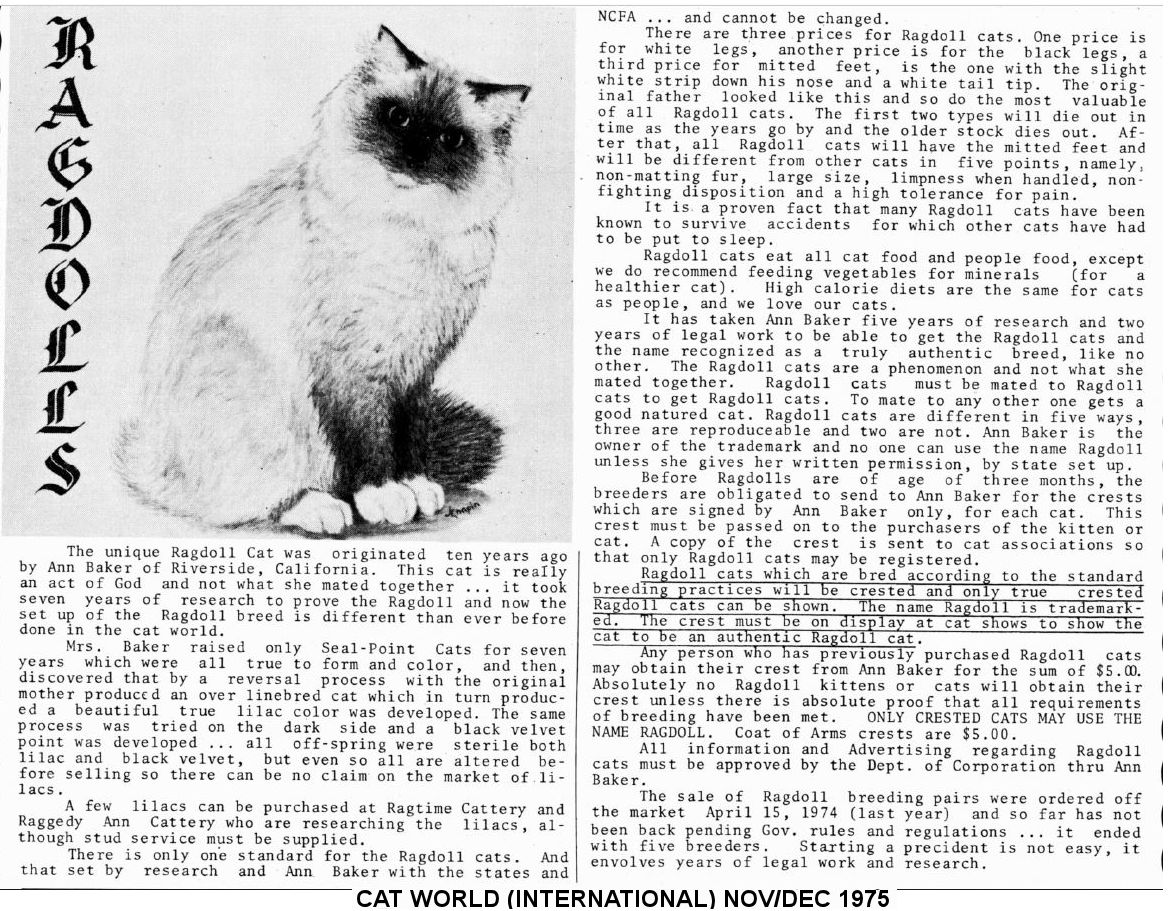
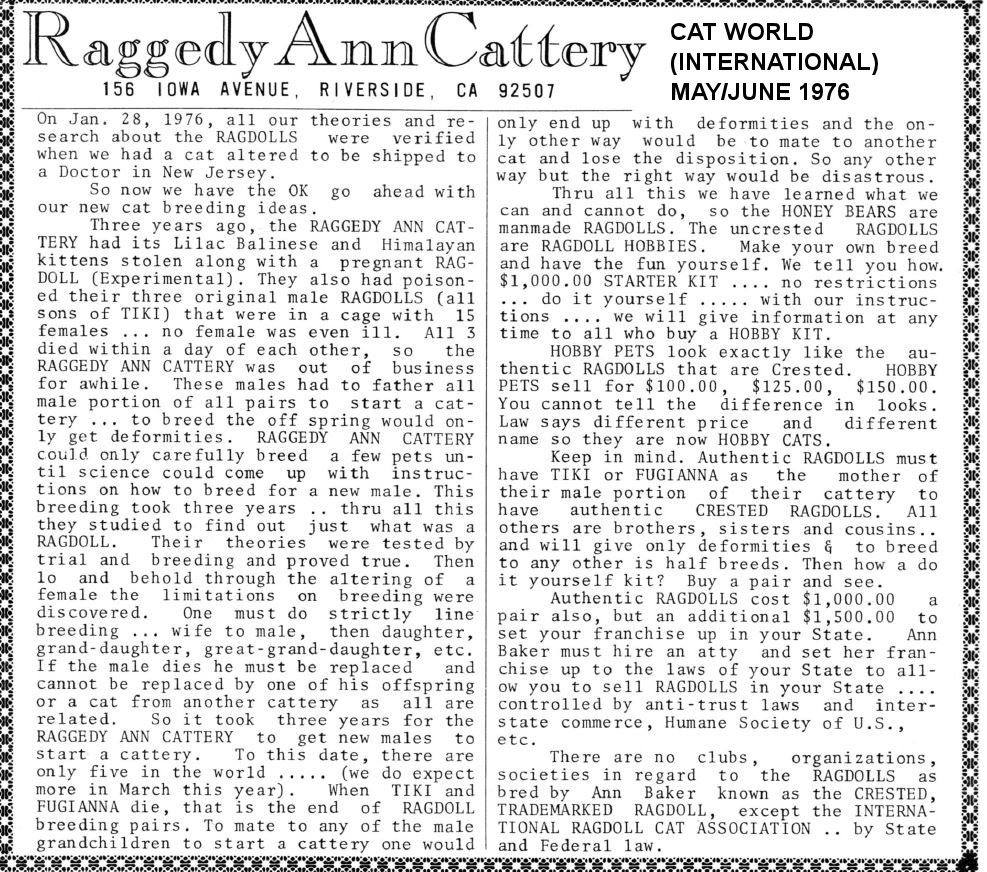
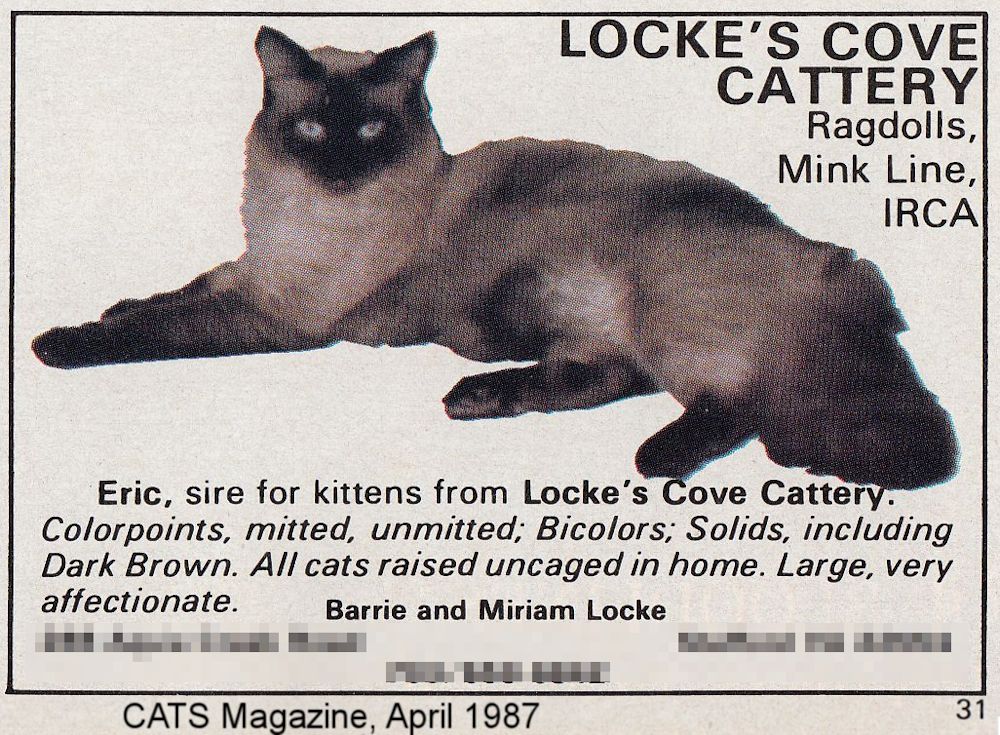
RAGDOLLS
Ragdolls are medium to large boned, fairly long cats and possess the Siamese colourpoint gene and the white spotting gene. The have broad modified wedge shaped head - best described as a large piece of pie, with the corners rounded. Their ears are wide set and slightly tilted forward and the eyes are very blue, but not round in shape.
The Ragdoll comes in seal point, chocolate point, blue point and lilac point although red points, cream points and tabby points are now being bred. The "colourpoints" are exactly that. The "mitted" versions have the colour points but have white mittens, white boots and a white blaze on the nose. The "bicoloured" has additional white on the stomach, chest and ruff. Genetics means that there are three other patterns: "High Mitted" where the mitts extend up legs; "Mid-High White" which is a Bi-colour with additional white in the "saddle" area; and "High White" (known as Van pattern or Harlequin in some associations and is a recognised colour in CFA (America)) which is a Bi-colour with even greater degree of white, the "saddle" may be absent.
The colourpoint and white spotting genes interact to produce the different patterns. The three recognised patterns are colourpoint, mitted and bicolour. All Ragdolls are colourpointed and some also have white. Due to the way genes interact, some cats Ragdolls which look identical actually have different genotypes (different genetic make-up). For example, High Mitted, Mid High White and "true" Bicolour can all appear identical, though the exact amount of white is variable (almost infinitely so!) and some High Mitteds display more white than a show quality Bicolour while some Mid High Whites may have so much white on them that they appear to be High Whites! At times like this, only a knowledge of what genes the cat has inherited allows breeders to know what colour their cat really is!
RAGAMUFFINS
The RagaMuffin is another descendent of the original Ragdolls, but in a more extended colour range. Their similarity to the accepted Ragdoll meant that many registries would not accept them, though the conformation is not the same as the TICA Ragdoll (note: the NZCF accepts "Solid Ragdolls instead). In the days when Ann Baker and IRCA were active, a there were a number of other "breeds" or named breeding lines. IRCA's other named breeds/lines were the Honeybear/Honey Bear (IRCA's version of the old style Persians), Ragdoll Hobby Cat, Miracle Ragdoll ("a highly upgraded Ragdoll" formerly known as the "Ragdoll Tu", "experimental Persian" or simply "Miracle"), Baby Dolls/Doll Babies, Angels, Shu Schoo, Symoneese/Symonees, Manxees and Fuzz. The named IRCA Ragdoll/Miracle breeding lines included Maximillions (silver tabbies), Minks, Bears (thicker fur, shorter ears, rounder eyes, flatter face, cobbier body) and Catenoids (blue-eyed solids surrounded by claims they could be bred to any cat to produce an IRCA-type Ragdoll!). After the demise of Baker and of IRCA, the IRCA Ragdolls, Honey Bears and Miracle Ragdolls, not being accepted by other registries, were either merged into the RagaMuffin or re-registered as TICA Ragdolls.
Although bred with the Ragdoll to begin with, the modern RagaMuffin has a shorter nose with an obvious nose dip, and the eyes are walnut-shaped rather than oval. RagaMuffin breeders have worked to produce a rounded, more heavily boned cat by outcrossing to Persians/Himalayans and have used domestic longhairs to give the breed a sound genetic footing. The plushy coat is shorter and thicker than the Ragdoll's medium-long, silky coat. Some registries only recognise non-pointed RagaMuffins (feeling pointed varieties are too similar to Ragdolls), others also recognise the pointed varieties.
More information comes from a RagaMuffin breeder who has experience of the early days of the breed and the current situation. Her RagaMuffins are registered by CFA, ACFA and TICA, and (in 2018) registration with GCCF was pending. The TICA situation is complicated because the breed is registrable with TICA but is not recognised for championship status, but registering authentic, pedigree RagaMuffins is necessary to combat the many Ragdoll crosses being passed off as RagaMuffins. The information comes from some of the early RagaMuffin breeders. Janet Klarmann (now deceased) and Kim Clark were integral to the breed’s formation by leaving IRCA along with the late Kurt Gehm.
TICA only recognise pointed Ragdolls although other patterns existed, especially in the original foundation stock first registered, though there seems to be confusion on whether they were intentionally registered or whether they ‘slipped in,’ possibly mislabelled. Breeders of the real multi-generation RagaMuffins can personally attest to how confused kitten adopters are regarding the differences of RagaMuffins, Ragdolls, TICA-registered solid/mink/sepia Ragdolls, and TICA "registration only" RagaMuffins. TICA is very muddled regarding RagaMuffins. RagaMuffins can be registered with TICA, but it is more-or-less the only major registry that does not recognise the breed for Championship status. Currently any cat (absolutely any cat!) can be registered as a RagaMuffin foundation cat. Any Ragdoll cross can be registered with TICA as a RagaMuffin because the breed isn’t recognized. At the same time, solid/mink/sepia Ragdolls are accepted by TICA for breeding although they can’t be shown. The result of this has been a proliferation of backyard breeders exploiting public ignorance. Some of these have been buying Ragdolls from a notorious (in the cat fancy) bulk breeder, breeding these to whatever they want and selling the progeny as TICA registered RagaMuffins, often for many times the price of a genuine RagaMuffin. Breeders of genuine pedigree RagaMuffins have looked into getting RagaMuffins officially recognized in TICA, but TICA rules would insist on absorbing all the backyard breeders producing mongrel “foundation cats.” Any "TICA RagaMuffin" that can’t also be registered with one of the registries that accept RagaMuffins for championship status (CFA, ACFA, GCCF, WCF, CCA/CCC) is a fake.
[The notorious breeder, – described as a “cat broker” - Jessica Perry of “We Love Ragdolls,” “ElegantRags” and numerous other aliases, has been subject to a class action lawsuit (against both Jessica Perry and Leah Keeran) over the sale of sick and even dying kittens (no vet papers, no vaccinations, no pedigree papers). The breeder also sold "Calico Ragdolls" (there is no such breed). Perry was last known to be operating out of Wichita, Texas, having previously operated in South Carolina and then to Louisiana. There are numerous consumer/ripoff reports online about the operation. While backyard breeders advertise crossbred kittens as RagaMuffins on selling sites for $200-$500 range, some want up to $875 for Ragdoll/Persian mixes, and Perry asked for $4000 for a pet, $6000 for a breeding cat (that cannot be registered with CFA, ACFA, GCCF, WCF, CCA/CCC) - more than any legitimate RagaMuffin breeder asks. ]
HONEY BEARS
Honey Bears were IRCA's take on the tradtional style Persian.
Honey Bears had been bred from a pair of Persian cats and could be registered as Persians with the CFA. Ann Baker claimed skunk genes were infused into the female and her kittens then resembled young skunks, being born silver before turning black with stripes along the head, back or underside. To the rest of the cat world, this sounds like shaded silvers developing their colour. The cats supposedly has tails flatted on the sides - actually an illusion caused by long fur - that they held over their backs like skunks. Baker claimed the Honey Bear looked like a Persian, but did not have a cat skeleton. Essentially the cats were Persians and were even marketed as non-matting Persian lookalikes, but Baker's breeding philosophies and increasingly wild claims, led to them becoming unregistrable as Persians with conventional registries. For all practical purposes, Honey Bears were Persians, albeit less extreme in type than those seen on the showbench. A few breeders persevered with them, but otherwise they were absorbed into the RagaMuffin.
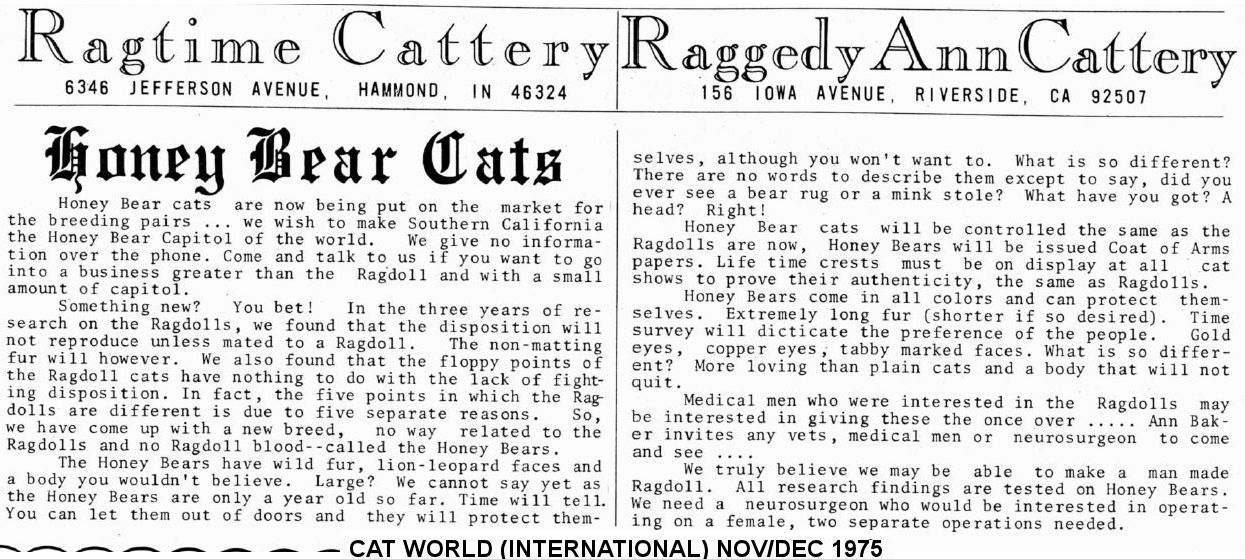
MISCELLANEOUS IRCA "BREEDS"
Miracle Ragdolls ("highly upgraded Ragdolls") were mentioned in some of Baker's IRCA advertisements and were also merged into RagaMuffins after her death. Her press releases became increasingly vitriolic towards the breakaway Ragdoll breeders and their "half-bred" or "overbred" copies of her cats. Catenoids and Little Americans also appeared in IRCA adverts close to the end of Baker's life. Most of the other "breeds" seemed to be products of a fertile imagination rather than distinct types of cat.
